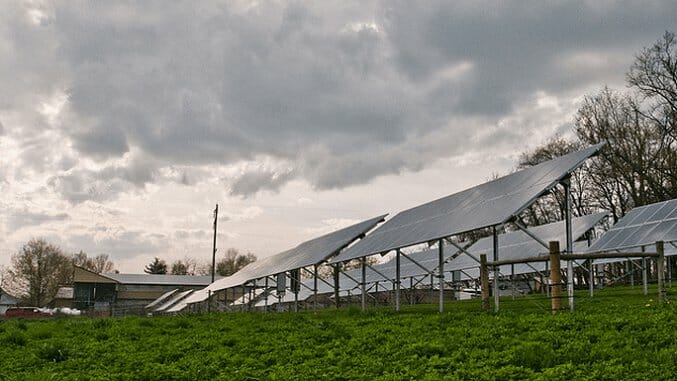Dissecting Trump: Just Embrace Solar, Not A Solar-Wall

At a rally in Iowa last week, Donald Trump had his God-awful proposal for a wall along the U.S.-Mexico border on his mind. This time, Trump seems have abandoned the Mexico-will-pay-for-it-all rhetoric and, instead, suggested that solar panels would make a effective border, so effective that the U.S. could then sell the resulting energy to Mexico at a cost; thus, ensuring a Mexican-paid wall.
“Lots of sun, lots of heat,” Trump said, almost as if talking to a group of preschoolers, at the rally in Cedar Rapids. “Think about it, the higher it goes, the more valuable it is. Pretty good imagination, right, good?”
“My idea.”
It’s…an idea. Not the best idea, but it’s not the worst idea (because a concrete wall is the worst idea—or rather a wall built out of puppy heads is probably the absolute worst idea). That said, putting solar panels on a stupid wall doesn’t change the fact that the wall itself is stupid.
![]()
For starters, this idea indicates Trump has no idea how solar-power works. The president needs to understand that, while technologically feasible, there are dozens upon dozens of more technical and cost considerations than just slapping solar panels onto a 2,000-mile concrete wall like you’re tiling your uncle’s bathroom. The panels need to be sloped at specific angles, while, at the same time, mounted in such a way that’d prevent people from entering. There’s also the issue that the wall will be 40-feet high. Don’t forget: The entire stretch of the border will need a fucking power grid.
Trump says this has the potential to make the U.S. money. Thankfully, Liam Denning at Bloomberg went ahead and calculated this cost, and it’s so much that even the sun can’t afford it. Construction of the 1,933-mile, forty-foot tall solar wall alone would cost $40 billion, and about $20 billion of that would be paid by taxpayers.
As if the price tag isn’t alarming enough, Denning says that “assuming all this and that the solar wall was somehow completed by 2020, it would have paid for itself by the year … 2168.” That’s about 37 election cycles away—or, as close to now as the current president is to the days of Ulysses S. Grant. None of this even factors in the additional complexities like permits, varying regulations crossing state and country lines, all while leaving aside the reality that mounting solar panels atop or lining the sides of a giant wall is probably the least effective way to maximize solar output. If it were effective, energy companies would be doing this already.
Oh, and all of the power generated from the border wall, Trump says it’ll be sold to Mexico as payment for the wall, which, by the way, Mexico has continuously said will not pay for that fucking wall.
Trump also doesn’t realize the sheer scale of a solar-wall project. Either that or Trump is the biggest proponent of solar energy the United States has ever seen, which is surprising because just a few months ago, his budget proposal completely undermined the solar industry.
A solar wall of this magnitude would multiply U.S. solar output by 50 times, and it’d require more than twice as much concrete to build as the Hoover Dam, making it one of the biggest construction projects in U.S. history—up there with the Panama Canal.
-

-

-

-

-

-

-

-

-

-

-

-

-

-

-

-

-

-

-

-

-

-

-

-

-

-

-

-

-

-

-

-

-

-

-

-

-

-

-

-








































